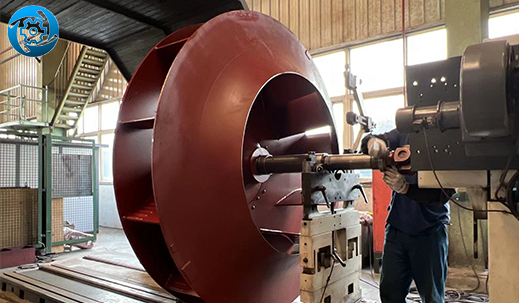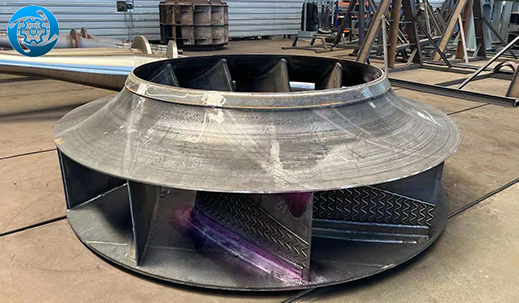Received an inquiry from a new customer today, the customer is a well-known local petrochemical company. The previously purchased centrifugal combustion-supporting blower had blade wear. So we recommended wear-resistant treatments and new fans to our customers.
Fan impeller wear is related to abrasive composition, particle size, concentration, shape, impact speed, impact angle, chemical composition, performance, temperature, and humidity. Uneven airflow inside the impeller accelerates wear. As measures to prevent impeller wear: one is to reduce the dust and corrosive gases entering the fan, for which the fan operating system must be modified; the second is to try to make the local wear tend to wear evenly, which requires improving the wear resistance of the impeller. If the wear resistance of the impeller is improved, materials with high hardness and good wear resistance can be selected. This not only makes the impeller manufacturing process difficult but also unreasonable from an economic point of view. Therefore, it is an economical and reasonable solution to improve the surface quality of the impeller of the fan, surfacing or spray welding the wear-resistant layer on the seriously worn part of the impeller, and adding a layer of lining plate on the blade. to achieve wear resistance.
Apply an anti-wear coating. The main wear-resistant coatings include resin anti-corrosion and wear-resistant coatings, rubber anti-corrosion and wear-resistant coatings, quartz and water glass, and ceramic anti-corrosion and wear-resistant materials. 890 Wear-Resistant Composite is a ceramic composite used to repair and protect worn metal surfaces. However, the coating thickness of the 890 wear-resistant compounds must reach more than 6mm, which is not suitable for some rotors with narrow flow channels or strict starting requirements. There is also such a problem with impeller wear.
The surface surfacing of the blade, the surface surfacing is to select a certain surfacing electrode, and perform manual arc surfacing on the parts that are easily worn by the blade to improve the surface quality of the blade, protect the blade, improve the service life of the blade, and have a certain anti-wear ability. , but the surfacing cracks are often larger. Surfacing material is a surfacing alloy composed of a large number of tungsten carbide particles distributed on the metal matrix. Due to the high melting point and hardness, the hardness of the weld metal is also high, with impact resistance, and hardness HRC≥60. Weld metal is not prone to cracking.
The high-pressure centrifugal fan, surface spray welding, and spray welding process is a process of spraying and melting self-fluxing alloy powder on the surface of the workpiece with a heat source to form a dense spray welding layer. There is a large number of boron compounds and tungsten carbide, these particles are uniform and discontinuous and can withstand high abrasive wear when washed with abrasive grains

 Español
Español Русский
Русский Tiếng Việt
Tiếng Việt 中文
中文 suomi
suomi Français
Français Português
Português English
English Deutsch
Deutsch Français
Français Español
Español Italiano
Italiano Português
Português Pусский
Pусский



